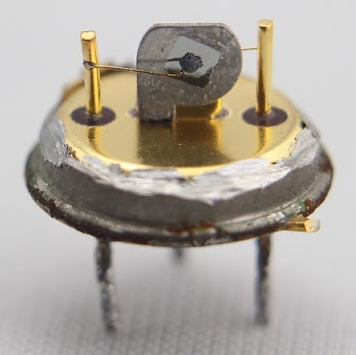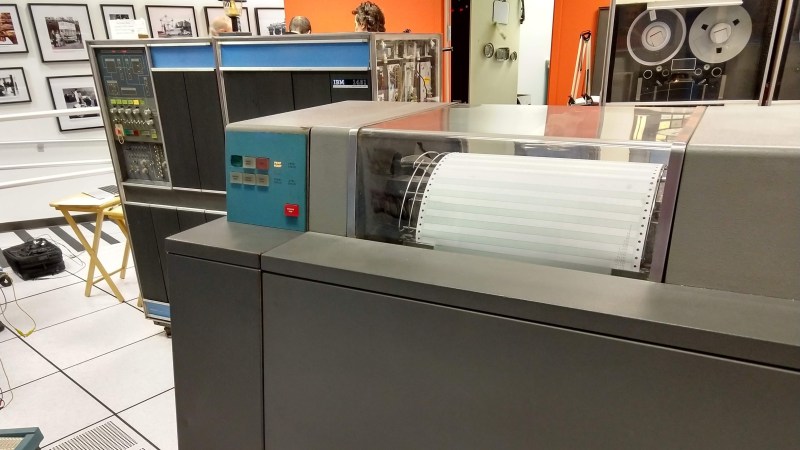The IBM 1401 is a classic computer which IBM marketed throughout the 1960s, late enough for it to have used transistors rather than vacuum tubes, which is probably a good thing for this story. For small businesses, it was often used as their main data processing machine along with the 1403 printer. For larger businesses with mainframes, the 1401 was used to handle the slower peripherals such as that 1403 printer as well as card readers.

The Computer History Museum in Mountain View, CA has two working 1401s as well as at least one 1403 printer, and recently whenever the printer printed out a line, the computer would report a “print check” error. [Ken Shirriff] was among those who found and fixed the problem and he wrote up a detailed blog entry which takes us from the first test done to narrow down the problem, through IBM’s original logic diagrams, until finally yanking out the suspect board and finding the culprit, a germanium transistor which likely failed due to corrosion and an emitter wire that doesn’t look solidly connected. How do they know that? In the typical [Ken]-and-company style which we love, they opened up the transistor and looked at it under a microscope. We get the feeling that if they could have dug even deeper then they would have.
If you’re unfamiliar with the work of this team who maintain the machines at the museum, you’ll want to read up on how they recently got a 1401 to run FORTRAN II code.
















Someone in the (original blog) comments mentioned “fond memories” of working on these printers. That most definitely is a case of “rose tinted”. :-) It was like working on a chainsaw (case open, printer running and -carefully- probing with the two-channel Tek) as well as being horrendously noisy and incredibly dirty. They were amazing machines, but not much fun to actually work on …the paper was moving so fast that it could cut, let alone the chain.
This was the computer where I learned to program back in 1965, in the Army. I had a 4K system and an 8K system. (YUP, real magnetic core memory back in those days, and yes, 4K is correct.) My 1401’s were connected to a 1402 card reader/punch, and a 1403 line printer. The line printer advancement was controlled by a paper tape, punched for a stop at each specific print line on the tractor-feed printer. The programs were written in an assembly-language called AUTOCODER, and when you printed out the output of a card or instruction, you also had to specify each stop and start position explicitly by coding it. The printer used a “type bar” which was like a chain of letters and other characters that traveled rapidly around spindles and was pounded by a hammer at precisely the right moment to create the right character in the right place.
My little comm center had a keypunch machine that had been re-engineered to transmit the contents of batches of Hollerith cards over a phone modem. The military had their own private lines on a network called AUTODIN, which was similar to the dedicated WATS lines in use commercially at that time. AUTODIN was the precursor to to ARPANET. It was not nearly as robust but had some fail-over protections. Later my unit was hardened and we used ciphony units between the modem and the transmitter.
I learned to program the IBM System 360 using BAL before working for a bank that had IBM 1440’s and learning FORTRAN II.
The best thing about learning to program from IBM was the instructional materials. The manuals for AUTOCODER were written in a format called “programmed instruction”, which I loved. If I knew where to find these two manuals I would get them just for memory’s sake.
I also think it is interesting that after 53 years, I am still doing what the Army said I was best suited for; trained as a comm center operator and assigned to computers.
FYI, the referenced article gives a better description of the “type chain” than I did. Now back in those days we still called it a “type bar” but it was, in fact, a chain.
I had the chance, in high school, to learn how to wire-program (look it up) a 402 accounting machine. It had actual type bars…a vertical bar for each column, which rose to the level of the letter (or number) being printed, and was then whacked from the opposite side of the paper by an electromagnetic print hammer.
Ahhh…the memories. Printing sounded like “ka-CHUNK, ka-CHUNK…” where the “ka-” part was the card reading in and the type bars positioning, and the “CHUNK” was all the print hammers firing at once. The 402 was completely mechanical, with relay logic.
Lucky thing those 1401 repair guys had a “spare card”, but I would have awarded bonus points if they had made their own replacement Germanium transistor.
I entered ‘autocoder’ into archive.org and there are a few manuals there, probably from bitsavers https://archive.org/search.php?query=autocoder
Could any of these be the ones you’re after?
Thanks for trying, but none of those saved documents are the books I was looking for. The two books I started with were softbound, about letter-size, mostly Green with some White on the cover.
One of the books I found at the Archive was https://ia601207.us.archive.org/3/items/bitsavers_ibm1401Pro_6215228/Programming_the_1401_1962.pdf which seems to contain much of the same content I remember from the second book I read. The first book was all about using flowcharts, IBM flowcharting templates, and IBM flowcharting sheets (tabloid-size?) to design and desk check your program before converting it to code.
The printing was very noisy, but generated tones if you printed the right sequence of characters – so – we played music. The paper got very dark from overwritten characters, but who cared.
And the operators noted that when running some programs an FM radio sitting on top of the 1401 would sometimes emit tones. Another chance to play the Wittenberg fight song! After some serious programming of course.
Fun machine. Great memories.
I worked on the 1401/1460 and the 1440 starting in 1962. My company had 4 of them in different configurations. I was called a systems programmer. My primary job was to assist other programmers in debugging and improving their programs. I still have a copy of a 1401 manual. We had all the peripherals (1402, 1403, 729) Later we acquired the 1428 document reader. We also got a disc drive, the 1311. We had a 7070 and a 7074. These were are primary computers for important business applications. The 1401 was used as a slave to the 7070. The 7070 did not have a card reader or a printer. Neither did the 1401 or 7070 have an operating system. I recall that an early version of the 1401 did not have multiply or divide and had to use a subroutine for these functions.
When I first started at IBM the 1403’s were still in use at some customers. They were both awesome and scary in operation. I’ve never seen anything like them before or since. They were housed in a special cabinet which served both to keep you from going deaf and from cutting off a body part.
The noise and power were awesome to behold and the print speed was breathtaking (for the time).
Reading the diagnostic and repair story reminds me of how good at their job the IBM service techs were. I learned a lot from those folks.
I love reading all the stories above. What a rich history we have in the past experiences of our fellow Hackaday readers. Based on the above, Hackaday readers appear to reach in age easily into their 60’s, 70’s, and 80’s (and maybe higher?).
Would be neat for Hackaday to do a voluntary survey and publish some anonymous fun facts about the general make-up of its readership.